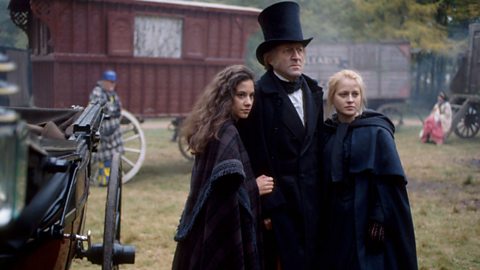Analysing character and voice in an extract
Example
This extract from Charles DickensвҖҷ Hard Times introduces Mr Gradgrind, the headmaster of a school. What do we learn about this character?

Now, what I want is, Facts. Teach these boys and girls nothing but Facts. Facts alone are wanted in life. Plant nothing else, and root out everything else. You can only form the minds of reasoning animals upon Facts: nothing else will ever be of any service to them. This is the principle on which I bring up my own children, and this is the principle on which I bring up these children. Stick to Facts, sir!
The scene was a plain, bare, monotonous vault of a school-room, and the speaker's square forefinger emphasised his observations by underscoring every sentence with a line on the schoolmaster's sleeve. The emphasis was helped by the speaker's square wall of a forehead, which had his eyebrows for its base, while his eyes found commodious cellarage in two dark caves, overshadowed by the wall. The emphasis was helped by the speaker's mouth, which was wide, thin, and hard set. The emphasis was helped by the speaker's voice, which was inflexible, dry, and dictatorial. The emphasis was helped by the speaker's hair, which bristled on the skirts of his bald head, a plantation of firs to keep the wind from its shining surface, all covered with knobs, like the crust of a plum pie, as if the head had scarcely warehouse-room for the hard facts stored inside.
Hard Times, Charles Dickens
Analysis
- A third-person narrative voice is used.
- Gradgrind uses a lot of commands in his speech. This suggests that heвҖҷs used to being in charge. It doesnвҖҷt make him a very sympathetic character. We get the feeling that heвҖҷs very focused on what he thinks, rather than anyone elseвҖҷs opinions.
- He emphasises вҖҳFactsвҖҷ by using the capital letter вҖҳFвҖҷ. This suggests he has a narrow view of education.
- HeвҖҷs described in an unsympathetic way вҖ“ everything about him is вҖҳsquareвҖҷ.
- The narrator tells us directly that the characterвҖҷs voice is вҖҳdry and dictatorialвҖҷ. The narrator doesnвҖҷt approve of him either.
- Although the narrator seems to be describing the character in quite a factual way вҖ“ suggesting heвҖҷs neutral вҖ“ he starts to use some complicated imagery. GradgrindвҖҷs hair becomes fir trees that вҖҳbristledвҖҷ on his head, and his skin is вҖҳlike the crust of a plum pieвҖҷ. These are vivid and slightly disturbing images.